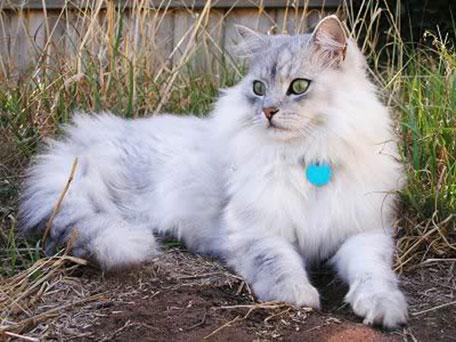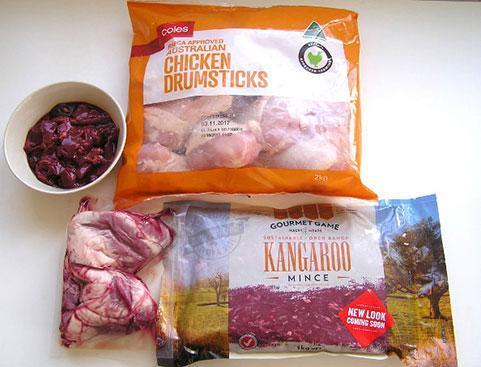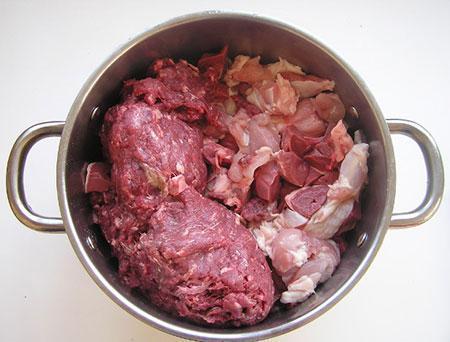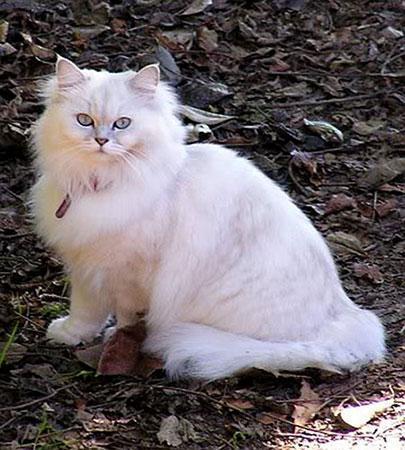This content is archived from the Feline Nutrition Foundation
Feeding Raw Food In Australia: What's Up Down Under
- Updated: Saturday, June 01, 2019 03:09 PM
- Published: Sunday, December 10, 2017 01:27 PM
- Written by Claire Hunt
 My first cat, Hamlet, taught me the value of feeding raw in 2005. A large, vigorous Persian cross whom I adopted from a shelter in Hobart. He was billed as being a stray although his social nature and lack of feral behaviour told me he had always been a house cat. Nevertheless, Hamlet was an expert hunter, bringing to my doorstep every other day a small rabbit from the wild population that blighted the neighbourhood. He proudly displayed his kill on my welcome mat until I viewed it, then he set about eating the entire thing, head, fur and tail. Nothing was left after he'd finished his meal. It was this vivid demonstration that made me accept the carnivorous nature of a cat, even the domestic cat, and their dietary needs.
My first cat, Hamlet, taught me the value of feeding raw in 2005. A large, vigorous Persian cross whom I adopted from a shelter in Hobart. He was billed as being a stray although his social nature and lack of feral behaviour told me he had always been a house cat. Nevertheless, Hamlet was an expert hunter, bringing to my doorstep every other day a small rabbit from the wild population that blighted the neighbourhood. He proudly displayed his kill on my welcome mat until I viewed it, then he set about eating the entire thing, head, fur and tail. Nothing was left after he'd finished his meal. It was this vivid demonstration that made me accept the carnivorous nature of a cat, even the domestic cat, and their dietary needs.
At 18 he is still an active, vigorous cat, although he has no suitable kills in my current location of suburban Brisbane and so I must provide for him. Brisbane is Australia's third largest city and sits on the eastern seaboard in the subtropics. The majority of the wildlife here are possums, brush turkeys and native parrots. All protected species. Brisbane is also home to a large python population who have been known to eat the odd cat. They mostly live in the roof spaces of the traditional Queenslander homes.
Game and Meat Availability
 Raw feeding is an emerging trend in Australia but there has always been an element of availability of suitable food in this country. Butchers and supermarkets have for decades sold chicken necks and frames for pet food and as an occasional treat to throw to the house cat and dog.
Raw feeding is an emerging trend in Australia but there has always been an element of availability of suitable food in this country. Butchers and supermarkets have for decades sold chicken necks and frames for pet food and as an occasional treat to throw to the house cat and dog.
Kangaroo mince has been commercially available in supermarkets nationwide for more than a decade in both pet and human grade. Kangaroo isn't farmed but is instead culled from wild populations, making it a true game meat. It is also extremely lean at just 2 percent fat. My own cat food mix contains a blend of chicken, kangaroo, chicken or emu liver and lamb hearts. Back in the 80's, locally caught wild rabbit was a feature of many butchers at cheap prices; although now it appears to be the preserve of gourmet butchers at very high prices.
Wild rabbit populations, our biggest environmental pest, are being hit hard by the calicivirus introduced in the 1990s. Several eradication programs had been used previously, including physical destruction of warrens and the mixomatosis virus. None were truly successful. Even hunting could not keep the populations down. But the introduction of the calicivirus wiped out 95 percent of the population of wild rabbits, reducing the availability of the meat to butchers just at a time when it was rising in popularity as a commercial meat.¹
Wild rabbit was replaced by commercial rabbit farms that now face closure due to the high cost of vaccinating their stock against the calicivirus. Human consumers find the less gamey meat more palatable. A single rabbit sells for almost $30, too expensive for pet meat, even too expensive for many restaurants. When I lived in Hobart a wild rabbit could be had for $12 whole, although I had little need to buy them.
 The Primal MovementThe popularity of primal diets in this country has had a positive effect on the diets of our pets. The idea of a natural, bio-appropriate diet for humans is being taken up and Australians are thinking more critically about what they are feeding their pets as a result. But feeding raw is still viewed with skepticism by many. The convenient and inexpensive nature of kibble as well as the sale of prescription kibble diets by most veterinary surgeries means most people accept that a dry diet is appropriate for their pets. While few argue that a raw diet is harmful and acknowledge that it may even be natural, the expense and effort required still represents a divide for the majority. Raw diets are still seen as a luxury designer diet rather than a necessity for companion animals. I've yet to find a vet that argues against feeding raw meat on anything except salmonella and deficiency grounds. The major concern with raw diets is the difficulty in properly formulating a diet that contains all the nutritional needs for the cat or dog - due to a lack of good information - and concerns over pet meat that contains preservatives which lead to deficiencies.
The Primal MovementThe popularity of primal diets in this country has had a positive effect on the diets of our pets. The idea of a natural, bio-appropriate diet for humans is being taken up and Australians are thinking more critically about what they are feeding their pets as a result. But feeding raw is still viewed with skepticism by many. The convenient and inexpensive nature of kibble as well as the sale of prescription kibble diets by most veterinary surgeries means most people accept that a dry diet is appropriate for their pets. While few argue that a raw diet is harmful and acknowledge that it may even be natural, the expense and effort required still represents a divide for the majority. Raw diets are still seen as a luxury designer diet rather than a necessity for companion animals. I've yet to find a vet that argues against feeding raw meat on anything except salmonella and deficiency grounds. The major concern with raw diets is the difficulty in properly formulating a diet that contains all the nutritional needs for the cat or dog - due to a lack of good information - and concerns over pet meat that contains preservatives which lead to deficiencies.
While branded ready-made raw diets are still in limited number and not often stocked in major outlets, we do not lack for availability of fresh meat, farmed and wild. Australia's low, sparse population has long been a challenge for consumer products and pet raw diets are no different. But resourcefulness and a do it yourself attitude has birthed a network of pet meat butchers and boutique diet manufacturers across the country. Most of them sourcing and selling human-grade meats for pet use. Many offer delivery of a frozen product within major metropolitan areas and most offer a fully ground product for home use, either with or without supplements.
My local pet food butcher in Capalaba caters exclusively to raw feeding. They provide a large assortment of meats and organs including wild kangaroo, emu, goat, sheep and green tripe. The kangaroo meat is sold as forequarters, in chunks and also ground, vacuum packed on the spot. Prices are very affordable with discounts being offered for bulk purchases. They also stock a large array of pet food hide treats, supplements and dried organ treats.
 Even if you are not fortunate enough to have a fresh pet meat butcher locally, the major supermarkets, with some exceptions, stock human-grade kangaroo and chicken at affordable prices. While the pet-grade kangaroo mince is slightly less expensive, it does contain preservatives which the human version does not. Pet meat is unregulated in this country and so there is no restriction on the addition of preservatives that dramatically extend shelf life. However, the use of preservative 220 (sulphur dioxide) is controversial, with some health experts claiming it is harmful to pets, causing thiamine deficiency.²
Even if you are not fortunate enough to have a fresh pet meat butcher locally, the major supermarkets, with some exceptions, stock human-grade kangaroo and chicken at affordable prices. While the pet-grade kangaroo mince is slightly less expensive, it does contain preservatives which the human version does not. Pet meat is unregulated in this country and so there is no restriction on the addition of preservatives that dramatically extend shelf life. However, the use of preservative 220 (sulphur dioxide) is controversial, with some health experts claiming it is harmful to pets, causing thiamine deficiency.²
You'll also find lamb, beef and chicken hearts and livers in the supermarket as well. The popularity of primal diets for people has been a blessing for pets, with higher availability of products on supermarket shelves. Human-grade kangaroo mince is stocked by the major supermarkets and I've found it just about everywhere I have lived, both in metropolitan and country areas. Priced at less than $9 per kilogram, it's quite affordable.
Making the Feline Nutrition Diet
I mix kangaroo with a more bland meat such as chicken as I find it can be a little rich on its own for my cats. They can sometimes develop a slight digestive upset eating only kangaroo and organ meat. The addition of two parts chicken to one part kangaroo seems to work well for them. A three kilogram pet food batch lasts both my cats almost ten days. I freeze it in 500 gram batches and thaw as needed.
I feed my own cats in chunks to provide them with stimulation in their eating. They've been eating a raw food diet most of their lives including chewing whole raw bones, so they have no aversion to meat chunks.
I use chicken drumsticks for pet meat as it's generally around $3 kilogram and widely available. I remove the meat from the bone by slicing into bite sized chunks and feed the left over bone to my kitties with their meal to ensure they are getting their calcium. I find mixing my batches in a large boiler pan the easiest way to handle the volume.
Finding some of the supplements for the raw food diet was a challenge. It's difficult to find a powdered Vitamin B product in Australia as the majority of Vitamin B products are tablets. But I did manage to source all the products required.
 Vitamin B Powder: Blooms Ultra B Complex is a powdered capsule easily used for this purpose. It can be ordered through most online pharmacies if not stocked in your local health food store.
Vitamin B Powder: Blooms Ultra B Complex is a powdered capsule easily used for this purpose. It can be ordered through most online pharmacies if not stocked in your local health food store.
Vitamin E Liquid: Capsules for these can be found in any supermarket.
Lite Salt: The only brand for this we have is Diet-Rite Lite Salt which is stocked in all major supermarkets, except Aldi. It does not say if it is iodised or not.
L-Taurine: Can be sourced from any body builder supplier and most health food stores. I get mine from Bulk Nutrients based in Tasmania who offer a great product and very low shipping rates. They ship extremely quickly and I often receive my order within two business days.
Fish Oil: Widely available anywhere.
Additional Reading
Mangiare Crudo in Italia (Raw Fed in Italy)
Raw Cat Food and Kibble Don't Mix
Saving Alistair: How Lyn Thomson Helped Stop IBD 11,000 Miles Away
Once I became accustomed to measuring the various supplements, feeding my cats the raw diet felt natural and easy. Certainly no more work than feeding a prey-type diet and a tad more convenient in serving it.
The Advantages of a Bio-Appropriate Diet
My cats acted less hungry, were more active and did not suffer from obesity as many cats on kibble diets do. One dramatic outcome was with my girl cat, Jamaica. She came to me from the cool environs of the Blue Mountains in NSW where she had a thick but short coat. After six months of living with me her coat became dramatically full and long. Albeit we were in a slightly cooler climate than the Blue Mountains, her previous owner commented that she had never seen Jamaica with such a coat before.
Claire Hunt is an Australian cat lover and lives with two beautiful cats, Hamlet and Jamaica, in Brisbane, Australia.
1. Deborah Light, "Rabbits: From Pest to Plate," Australian Geographic, Feb 17, 2011.
2. "How is the Pet Food Industry Regulated in Australia?" RSPCA Australia, Feb 4, 2016.




